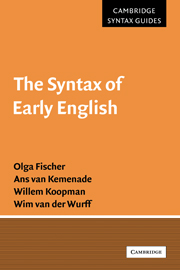Book contents
- Frontmatter
- Contents
- Preface
- List of editions used
- 1 Language change and grammar change
- 2 An outline of Old English syntax
- 3 An outline of Middle English syntax
- 4 The Verb-Second constraint and its loss
- 5 The loss of object–verb word order
- 6 Verb–particles in Old and Middle English
- 7 Changes in infinitival constructions
- 8 The history of the ‘easy-to-please’ construction
- 9 Grammaticalization and grammar change
- References
- Index
8 - The history of the ‘easy-to-please’ construction
Published online by Cambridge University Press: 23 December 2009
- Frontmatter
- Contents
- Preface
- List of editions used
- 1 Language change and grammar change
- 2 An outline of Old English syntax
- 3 An outline of Middle English syntax
- 4 The Verb-Second constraint and its loss
- 5 The loss of object–verb word order
- 6 Verb–particles in Old and Middle English
- 7 Changes in infinitival constructions
- 8 The history of the ‘easy-to-please’ construction
- 9 Grammaticalization and grammar change
- References
- Index
Summary
Introduction
In this chapter we consider in detail the history of a specific construction, the so-called ‘easy-to-please’ construction or ‘tough’ movement. Some modern examples are (1)–(3).
(1) John was easy to convince.
(2) The problem was tough to deal with.
(3) He is hard to get a straight answer from.
In each of (1)–(3), there is a sequence of an adjective plus an infinitival clause which is predicated on a noun phrase. The infinitival clause contains a nonsubject gap (in (1), the gap functions as direct object, in (2) and (3) as complement of a preposition), and the noun phrase in the superordinate clause provides the interpretation for this gap. Thus in (1), the speaker is talking about convincing John, not someone else, and (2) and (3) are about dealing with the problem and getting a straight answer from him, respectively. Although (1)–(3) all have the relevant NP functioning as subject of the verb be, this is not a necessary characteristic of the construction. Instead of be, the verb may also be another copula, like seem, appear, turn out or become, and there are also examples like (4).
(4) I consider Mary impossible to get along with.
In this sentence, although there is no copula between the noun phrase Mary and the sequence adjective–to-infinitive, it is nevertheless common practice to say that there is a subject–predicate relation holding between Mary and impossible to get along with (in terms of the analysis of Stowell 1981, 1983 and a great deal of subsequent work, the two elements would form a small clause).
- Type
- Chapter
- Information
- The Syntax of Early English , pp. 256 - 283Publisher: Cambridge University PressPrint publication year: 2001
- 1
- Cited by

